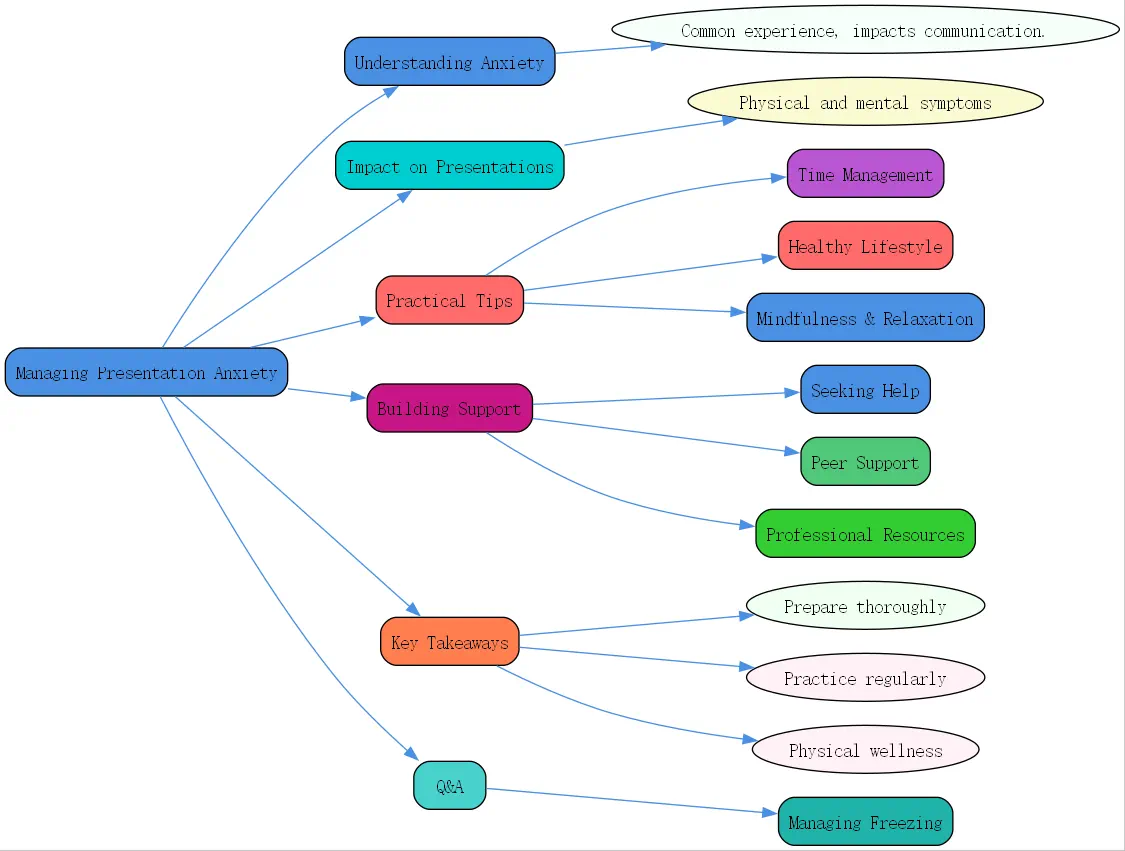Understanding Anxiety and Its Impact on Presentations

Anxiety during presentations is a common experience that affects many professionals and students alike. When we talk about managing your anxiety while presenting videos, we’re addressing a specific form of performance anxiety that can significantly impact your ability to communicate effectively.
Anxiety in presentation contexts manifests as a heightened state of nervousness, worry, or fear when faced with speaking in front of others, whether in person or on camera. This emotional response is often rooted in our natural fear of judgment and rejection, making video presentations particularly challenging as they create a permanent record of our performance.

The impact of anxiety on presentation performance can be substantial. When anxiety takes hold, your cognitive functions may become impaired, making it difficult to recall important information or articulate thoughts clearly. Your confidence levels drop, creating a cycle where anxiety feeds poor performance, which in turn generates more anxiety.
Recognizing the physical and mental symptoms of anxiety is the first step toward managing it effectively. Physical manifestations often include increased heart rate, sweaty palms, trembling voice, dry mouth, and shallow breathing. Mentally, you might experience racing thoughts, difficulty concentrating, negative self-talk, and catastrophic thinking patterns. By identifying these symptoms early, you can implement targeted strategies to address them before they escalate.
Practical Tips to Manage Anxiety and Stress
Time Management Strategies for Stress Reduction
Poor time management is one of the primary contributors to presentation anxiety. When you’re rushing to prepare content at the last minute, stress levels naturally increase, making it harder to present confidently. Implementing effective time management strategies is essential for managing your anxiety while presenting videos.
Prioritizing tasks is a fundamental skill for reducing overwhelm. Not all aspects of your presentation require equal attention. Focus first on developing your core message and supporting points, then move on to visual aids and delivery practice. This approach ensures that even if time runs short, you’ve addressed the most critical elements of your presentation.
Utilizing planners and to-do lists can transform how you prepare for presentations. Digital tools like Trello, Asana, or even a simple Google Calendar can help you visualize your preparation timeline. Block specific times for research, content creation, slide design, and practice sessions. Having a clear overview of your preparation process reduces the cognitive load of constantly deciding what to do next.
Breaking down large tasks into manageable steps makes presentation preparation less daunting. Instead of thinking, “”I need to create a 20-minute presentation,”” consider the individual components: research (2 hours), outline creation (1 hour), slide design (3 hours), script writing (2 hours), and practice sessions (4 hours). This approach not only makes the work more manageable but also provides a sense of accomplishment as you complete each step.
Healthy Lifestyle Choices for Managing OCD Anxiety
The connection between physical health and anxiety management is often underestimated. For those dealing with OCD anxiety or general presentation stress, healthy lifestyle choices can significantly impact your mental state and ability to cope with pressure.
Regular exercise is a powerful tool for managing stress and anxiety at work or during presentations. Physical activity stimulates the production of endorphins, which act as natural mood elevators and stress relievers. Even a 20-minute walk before a presentation can help calm your nervous system and clear your mind. For those with OCD anxiety, exercise can provide a healthy outlet for excess energy and reduce the intensity of intrusive thoughts.
A balanced diet supports optimal brain function and helps regulate mood, making it easier to manage anxiety. Foods rich in omega-3 fatty acids (like salmon and walnuts), complex carbohydrates (whole grains), and antioxidants (colorful fruits and vegetables) can help stabilize your mood and energy levels. When preparing for presentations, avoid excess caffeine and sugar, which can exacerbate anxiety symptoms and lead to energy crashes.

Adequate sleep is non-negotiable when it comes to managing anxiety. Sleep deprivation amplifies stress responses and reduces cognitive function閳ユ攨xactly what you don’t want before a presentation. Aim for 7-9 hours of quality sleep, especially in the days leading up to your video presentation. Establish a calming pre-sleep routine that might include reading, gentle stretching, or meditation to improve sleep quality.
Mindfulness and Relaxation Techniques to Reduce Anxiety
Incorporating mindfulness and relaxation techniques into your preparation routine can dramatically reduce presentation anxiety. These practices help you stay present and manage the physical symptoms of stress that often accompany public speaking.
Practicing mindfulness helps presenters stay grounded when anxiety threatens to take over. Mindfulness involves paying attention to the present moment without judgment, which can help break the cycle of anxious thoughts about future outcomes. Before recording a video presentation, try a brief mindfulness exercise: focus on your surroundings, notice five things you can see, four things you can touch, three things you can hear, two things you can smell, and one thing you can taste. This simple practice can anchor you in the present and reduce anticipatory anxiety.
Breathing exercises are particularly effective for calming the nervous system during presentations. The 4-7-8 breathing technique (inhale for 4 counts, hold for 7, exhale for 8) can quickly reduce anxiety symptoms. Box breathing (equal counts of inhale, hold, exhale, and hold) is another method that can be discreetly practiced right before or even during a presentation. These techniques work by activating your parasympathetic nervous system, counteracting the “”fight or flight”” response triggered by anxiety.
Progressive Muscle Relaxation (PMR) addresses the physical tension that accompanies anxiety. This technique involves systematically tensing and then releasing different muscle groups throughout your body. Before watch managing your anxiety while presenting videos, try spending 10-15 minutes on PMR to release physical tension. Start with your feet and work your way up to your face, tensing each muscle group for 5-10 seconds before releasing. This practice not only relaxes your body but also creates awareness of where you hold tension, allowing you to address it during your presentation.
Building a Support System to Cope with Anxiety
Seeking Help and Sharing Your Struggles
One of the most effective strategies for managing presentation anxiety is acknowledging that you don’t have to face it alone. BrainTalking experts emphasize that seeking help and sharing your struggles can significantly reduce the burden of anxiety.
Talking to trusted individuals about your feelings regarding presentations can provide both emotional relief and practical solutions. Choose people who are supportive and understanding, whether they’re colleagues, friends, or family members. Sometimes simply verbalizing your concerns can diminish their power over you. Additionally, others may offer perspectives or suggestions you hadn’t considered.
Finding solutions through communication often happens naturally when you open up about your challenges. A colleague might share a technique that worked for them, or a mentor could offer to watch your practice session and provide constructive feedback. At BrainTalking, we’ve found that many presentation skills improve dramatically when individuals engage in open dialogue about their anxieties rather than struggling in isolation.
Utilizing Peer Support Networks

The power of peer support in managing presentation anxiety shouldn’t be underestimated. Connecting with others who understand your challenges can provide both practical assistance and emotional reassurance.
Engaging with classmates or colleagues in practice groups creates a safe environment to refine your presentation skills. These groups can provide constructive feedback, help you identify blind spots in your delivery, and offer encouragement. For video presentations specifically, having peers review your recordings before finalizing them can help you make adjustments that significantly improve the final product.
Making academic or professional pressure feel more manageable often happens naturally in supportive peer environments. When you realize others share similar anxieties about presenting, the experience becomes normalized rather than isolating. Peer groups can also share resources, techniques, and tips for managing stress and anxiety at work or in academic settings.
Leveraging Professional Resources for Stress Management
Professional resources can provide structured support for those struggling with presentation anxiety or more specific conditions like OCD anxiety.
Counseling services offer personalized strategies for managing anxiety. A trained therapist can help you identify the root causes of your presentation anxiety and develop tailored coping mechanisms. For those with OCD anxiety that impacts presentations, cognitive-behavioral therapy (CBT) has proven particularly effective in changing thought patterns and behaviors that contribute to anxiety.
Stress management workshops provide practical tools and techniques in a supportive group setting. Many organizations and educational institutions offer these resources, which typically cover a range of anxiety management strategies from cognitive restructuring to relaxation techniques. BrainTalking also provides specialized workshops focused specifically on presentation anxiety, offering participants concrete methods to build confidence and reduce stress when speaking on camera.
Key Takeaways for Managing Presentation Anxiety
- Prepare thoroughly: Proper time management and preparation are your first line of defense against anxiety.
- Practice regularly: Familiarity with your material builds confidence and reduces uncertainty.
- Prioritize physical wellness: Exercise, proper nutrition, and adequate sleep significantly impact anxiety levels.
- Use relaxation techniques: Implement breathing exercises, mindfulness, and PMR to manage physical symptoms of anxiety.
- Seek support: Don’t face presentation anxiety alone閳ユ敂each out to peers, mentors, or professionals.
- Start small: Build confidence by presenting in less threatening environments before tackling high-stakes situations.
- Focus on your message: Shift attention from yourself to the value you’re providing your audience.
Q&A: Common Questions About Presentation Anxiety
How can I manage my anxiety if I freeze during a video presentation?
If you freeze during a video presentation, remember that this is a common experience and not a reflection of your competence. First, pause and take a deep breath to reset your nervous system. Having notes nearby can provide a safety net to help you get back on track. If you’re recording rather than presenting live, remember you can always pause and restart閳ユ敄his is actually an advantage of video presentations.
For live video presentations, develop a recovery phrase like, “”Let me elaborate on that point…”” which gives you a moment to collect your thoughts. Practice self-compassion rather than self-criticism if you stumble, as negative self-talk only increases anxiety. Finally, prepare for this possibility in advance by practicing what psychologists call “”exposure therapy””閳ユ攧eliberately making small mistakes during practice sessions to prove to yourself that you can recover gracefully.




